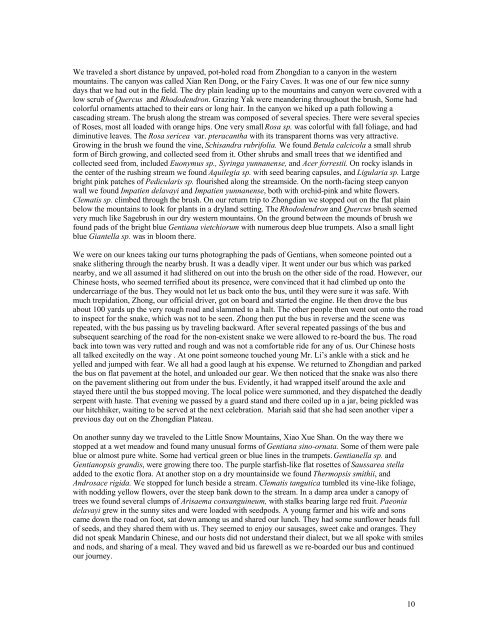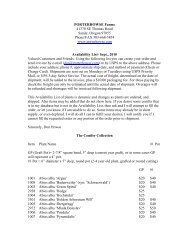CONIFERS IN YUNNAN.pdf - Porterhowse Farms
CONIFERS IN YUNNAN.pdf - Porterhowse Farms
CONIFERS IN YUNNAN.pdf - Porterhowse Farms
You also want an ePaper? Increase the reach of your titles
YUMPU automatically turns print PDFs into web optimized ePapers that Google loves.
We traveled a short distance by unpaved, pot-holed road from Zhongdian to a canyon in the westernmountains. The canyon was called Xian Ren Dong, or the Fairy Caves. It was one of our few nice sunnydays that we had out in the field. The dry plain leading up to the mountains and canyon were covered with alow scrub of Quercus and Rhododendron. Grazing Yak were meandering throughout the brush, Some hadcolorful ornaments attached to their ears or long hair. In the canyon we hiked up a path following acascading stream. The brush along the stream was composed of several species. There were several speciesof Roses, most all loaded with orange hips. One very small Rosa sp. was colorful with fall foliage, and haddiminutive leaves. The Rosa sericea var. pteracantha with its transparent thorns was very attractive.Growing in the brush we found the vine, Schisandra rubrifolia. We found Betula calcicola a small shrubform of Birch growing, and collected seed from it. Other shrubs and small trees that we identified andcollected seed from, included Euonymus sp., Syringa yunnanense, and Acer forrestii. On rocky islands inthe center of the rushing stream we found Aquilegia sp. with seed bearing capsules, and Ligularia sp. Largebright pink patches of Pedicularis sp. flourished along the streamside. On the north-facing steep canyonwall we found Impatien delavayi and Impatien yunnanense, both with orchid-pink and white flowers.Clematis sp. climbed through the brush. On our return trip to Zhongdian we stopped out on the flat plainbelow the mountains to look for plants in a dryland setting. The Rhododendron and Quercus brush seemedvery much like Sagebrush in our dry western mountains. On the ground between the mounds of brush wefound pads of the bright blue Gentiana vietchiorum with numerous deep blue trumpets. Also a small lightblue Giantella sp. was in bloom there.We were on our knees taking our turns photographing the pads of Gentians, when someone pointed out asnake slithering through the nearby brush. It was a deadly viper. It went under our bus which was parkednearby, and we all assumed it had slithered on out into the brush on the other side of the road. However, ourChinese hosts, who seemed terrified about its presence, were convinced that it had climbed up onto theundercarriage of the bus. They would not let us back onto the bus, until they were sure it was safe. Withmuch trepidation, Zhong, our official driver, got on board and started the engine. He then drove the busabout 100 yards up the very rough road and slammed to a halt. The other people then went out onto the roadto inspect for the snake, which was not to be seen. Zhong then put the bus in reverse and the scene wasrepeated, with the bus passing us by traveling backward. After several repeated passings of the bus andsubsequent searching of the road for the non-existent snake we were allowed to re-board the bus. The roadback into town was very rutted and rough and was not a comfortable ride for any of us. Our Chinese hostsall talked excitedly on the way . At one point someone touched young Mr. Li’s ankle with a stick and heyelled and jumped with fear. We all had a good laugh at his expense. We returned to Zhongdian and parkedthe bus on flat pavement at the hotel, and unloaded our gear. We then noticed that the snake was also thereon the pavement slithering out from under the bus. Evidently, it had wrapped itself around the axle andstayed there until the bus stopped moving. The local police were summoned, and they dispatched the deadlyserpent with haste. That evening we passed by a guard stand and there coiled up in a jar, being pickled wasour hitchhiker, waiting to be served at the next celebration. Mariah said that she had seen another viper aprevious day out on the Zhongdian Plateau.On another sunny day we traveled to the Little Snow Mountains, Xiao Xue Shan. On the way there westopped at a wet meadow and found many unusual forms of Gentiana sino-ornata. Some of them were paleblue or almost pure white. Some had vertical green or blue lines in the trumpets. Gentianella sp. andGentianopsis grandis, were growing there too. The purple starfish-like flat rosettes of Saussarea stellaadded to the exotic flora. At another stop on a dry mountainside we found Thermopsis smithii, andAndrosace rigida. We stopped for lunch beside a stream. Clematis tangutica tumbled its vine-like foliage,with nodding yellow flowers, over the steep bank down to the stream. In a damp area under a canopy oftrees we found several clumps of Arisaema consanguineum, with stalks bearing large red fruit. Paeoniadelavayi grew in the sunny sites and were loaded with seedpods. A young farmer and his wife and sonscame down the road on foot, sat down among us and shared our lunch. They had some sunflower heads fullof seeds, and they shared them with us. They seemed to enjoy our sausages, sweet cake and oranges. Theydid not speak Mandarin Chinese, and our hosts did not understand their dialect, but we all spoke with smilesand nods, and sharing of a meal. They waved and bid us farewell as we re-boarded our bus and continuedour journey.10




